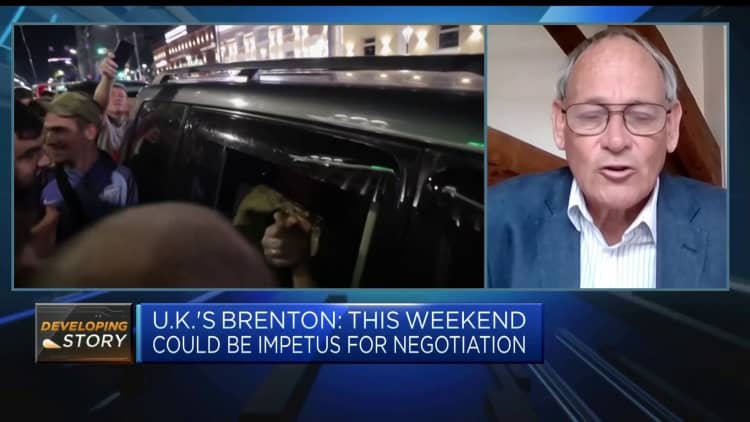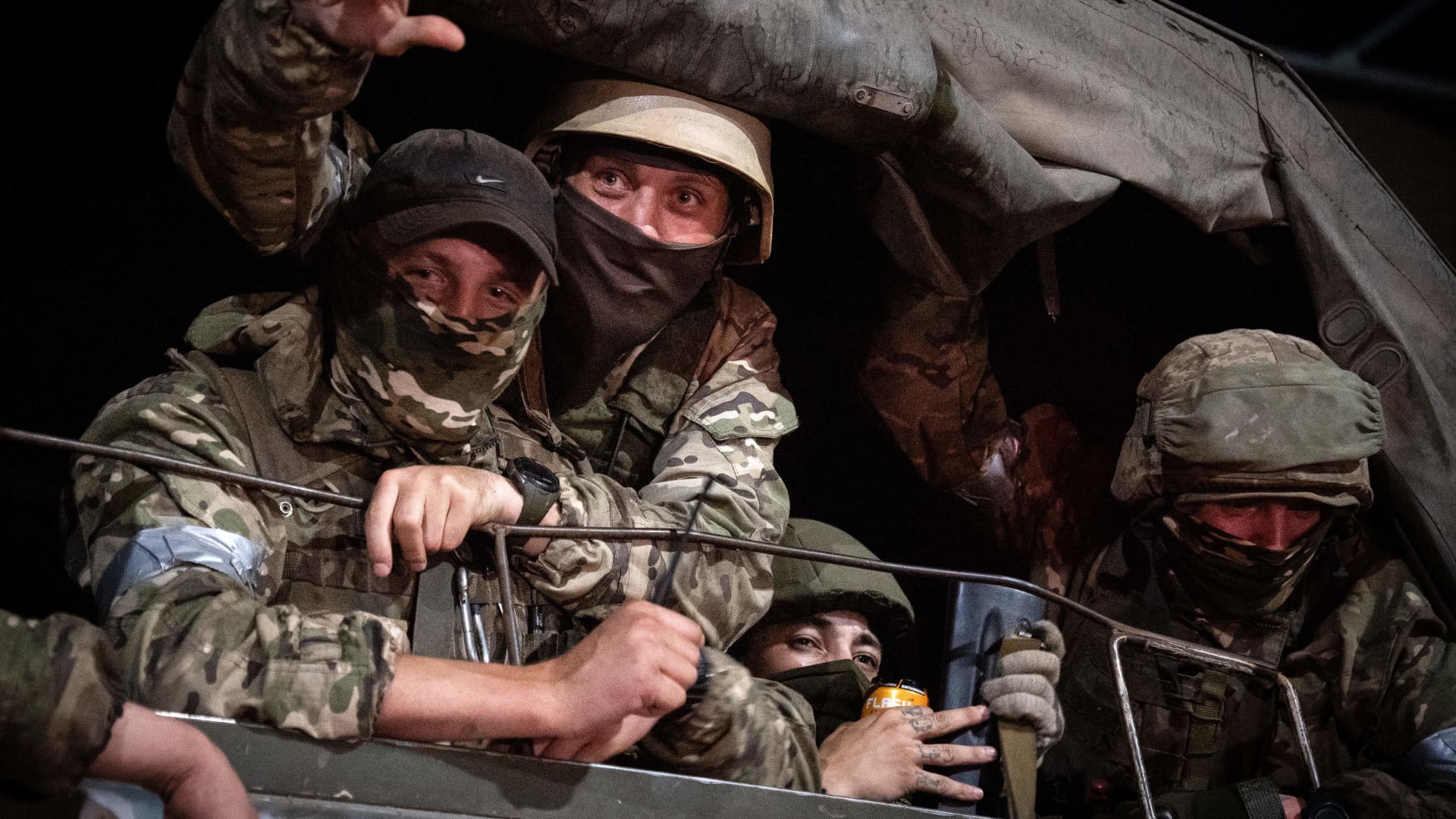Members of Wagner group looks from a military vehicle in Rostov-on-Don late on June 24, 2023.
Roman Romokhov | AFP | Getty Images
The recent Wagner rebellion exposed deep divisions within Russia’s military forces, raising questions about what it all means for the mercenary group’s fighters and the war in Ukraine.
In the space of just a few chaotic hours on June 24, the Wagner Group launched an apparent insurrection by sending an armored convoy toward the Russian capital. It marked what many regard as the greatest challenge to Russian President Vladimir Putin’s authority in his more than two decades in power.
The short-lived rebellion was abruptly called off, however, when Wagner boss Yevgeny Prigozhin agreed to de-escalate the situation and ordered his fighters advancing on Moscow to return to their bases.
The fallout has left many observers of Russia’s full-scale invasion of Ukraine asking what next for the Wagner Group’s future, both in Europe and across the globe.
The Institute for the Study of War, a U.S.-based think tank, said in its latest Russia offensive campaign assessment that the Kremlin may seek to assume formal control of the Wagner Group and turn it into a state-owned enterprise, although it is not yet clear if this is the Kremlin’s intention.
Russian President Vladimir Putin meets with servicemen at the Kremlin in Moscow on June 27, 2023.
Mikhail Tereshchenko | AFP | Getty Images
“The nationalization of Wagner would likely aid in the Russian Ministry of Defense’s (MoD) effort to subsume existing Wagner personnel into the regular Russian Armed Forces through contracts,” the ISW said Thursday.
“The Kremlin has not indicated that it intends to nationalize Wagner, and it is possible that Putin has yet to determine what course of action to take in subordinating the group more firmly under the Kremlin’s control.”
Putin said Tuesday that members of the Wagner mercenary group was entirely funded and fully supplied by the state. It was the first time the long-time Russian president had publicly acknowledged the group was funded by the Kremlin.
The ISW also noted recent satellite imagery collected between June 15 to June 27 appeared to show the active construction of a speculated new Wagner base in Asipovichy, Belarus. The site, the think tank said, is within 15 kilometers (9.3 miles) of a large Belarusian combine arms training ground.
It adds that Wagner personnel may deploy elsewhere in Belarus, however, and “there is nothing particularly unique” about a potential Wagner base in Asipovichy.
Wagner Group’s Prigiozhin arrived in Belarus on Tuesday shortly after agreeing to leave Russia in a deal brokered by Belarusian President Alexander Lukashenko. Belarus is an ally of Russia in Putin’s war in Ukraine.
What next for Wagner’s fighters?
The Pentagon has since said, however, that the U.S. continues to see “some elements” of the Wagner Group in Russian-occupied territory in Ukraine.
“In terms of the future of Wagner Group, that’s really a question best addressed by Russia, which of course … funds the Wagner Group, and how they will be employed going throughout the rest of this conflict and elsewhere around the world, since … they also conduct operations in Africa, as well as Syria,” Pentagon spokesman Brigadier General Pat Ryder told reporters on Thursday.
BANGUI, Central African Republic – March 22, 2023: A Russian flag hangs on the monument of the Russian instructors in Bangui, during a march in support of Russia and China’s presence in the Central African Republic. Wagner Group has been active in the country since 2018, supporting President Faustin-Archange Touadéra’s government and filling a security vacuum left by France.
BARBARA DEBOUT/AFP via Getty Images
Asked in a news briefing how many Wagner fighters were currently active in Ukraine following last weekend’s uprising, Ryder said some units of the mercenary group were still in the country but declined to provide a ballpark figure.
“That’s something that we’ll continue to keep an eye on. It’s just too early to tell right now,” Ryder said.
“My observation in all of this analysis on what could happen next is that there is a danger of not seeing the wood for the trees,” Christopher Granville, managing director of global political research at TS Lombard, told CNBC via telephone.
It’s essential to remain focused on the battle in Ukraine, Granville said, noting that Putin’s political future is dependent on the war’s outcome. “That’s really what it boils down to,” he added.
At best, Granville said the Wagner Group was likely to be “a shadow of its former self” in Ukraine following the revolt.
Russia’s political crisis
Russian Foreign Minister Sergey Lavrov on Friday dismissed questions about a political crisis.
Speaking at a news conference, Lavrov said that Moscow always emerges stronger and more resilient from any difficulties, Reuters reported. He added that if the West had doubts about Russia’s stability, that was their problem.
Elsewhere, Russian Gen. Sergei Surovikin, the deputy commander of Russian forces fighting in Ukraine, was believed to have been detained following the Wagner revolt, the Associated Press reported Thursday, citing two people familiar with the matter and Ukrainian intelligence assessments.
CNBC was not able to independently verify the report. It comes amid intense speculation about whether Surovikin played a role in the Wagner uprising.

Alexey Melnikov, the secretary of Russia’s Public Monitoring Committee, denied reports Surovikin was being held in Moscow’s Lefortovo pre-trial detention center or in any other temporary detention facility, according to state news agency TASS.
James Nixey of London’s Chatham House think tank said in a report outlining a sustainable and just end to the Ukraine war that the potential for political instability within Russia “should not be a deterrent to pressing home Ukraine’s advantage.”
“Indeed, the attempted Wagner Group mutiny … showed that domestic tumult can offer a tactical edge to Ukraine,” Nixey said Thursday.
His comments echoed the perspective of other analysts monitoring Russia’s war in Ukraine, with some saying Ukrainian forces can look to take advantage of confusion among Russia’s military leadership.


